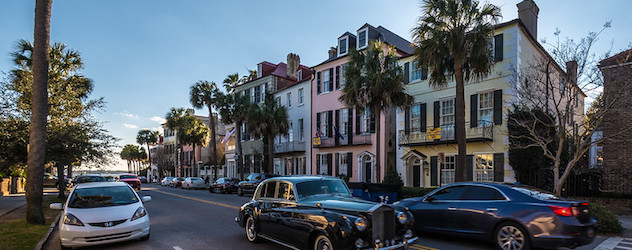As the cost of college continues to grow, so too does student loan debt in the United States.
To capture the increasingly heavy burden that student loan debt places on so many young Americans, LendEDU has published its fifth annual Student Loan Debt by School by State Report.
The report looks at the most recent student loan debt figures for close to 500 colleges and universities and uses that data to compile statewide student debt numbers.
Borrowers in the Class of 2019 from the following 10 states had the most student loan debt on average. To jump to the full list, click here.
1. Connecticut

- Average Student Loan Debt Per Borrower: $41,579
- Year-Over-Year Increase: 7.23%
- Proportion of 2019 Graduates With Student Loan Debt: 80%
- School With Highest Student Loan Debt Per Borrower: Southern Connecticut State University ($42,326)
2. New Hampshire

- Average Student Loan Debt Per Borrower: $41,511
- Year-Over-Year Increase: 12.94%
- Proportion of 2019 Graduates With Student Loan Debt: 81%
- School With Highest Student Loan Debt Per Borrower: University of New Hampshire ($42,246)
3. Pennsylvania

- Average Student Loan Debt Per Borrower: $38,521
- Year-Over-Year Increase: 8.48%
- Proportion of 2019 Graduates With Student Loan Debt: 64%
- School With Highest Student Loan Debt Per Borrower: Immaculata University ($55,126)
4. Delaware

- Average Student Loan Debt Per Borrower: $37,447
- Year-Over-Year Increase: 9.67%
- Proportion of 2019 Graduates With Student Loan Debt: 59%
- School With Highest Student Loan Debt Per Borrower: University of Delaware ($37,447)
5. Maine

- Average Student Loan Debt Per Borrower: $36,339
- Year-Over-Year Increase: 16.42%
- Proportion of 2019 Graduates With Student Loan Debt: 90%
- School With Highest Student Loan Debt Per Borrower: University of New England ($40,683)
6. North Dakota

- Average Student Loan Debt Per Borrower: $33,318
- Year-Over-Year Increase: 24.12%
- Proportion of 2019 Graduates With Student Loan Debt: 65%
- School With Highest Student Loan Debt Per Borrower: North Dakota State University ($33,639)
7. Minnesota

- Average Student Loan Debt Per Borrower: $33,168
- Year-Over-Year Increase: 3.94%
- Proportion of 2019 Graduates With Student Loan Debt: 72%
- School With Highest Student Loan Debt Per Borrower: University of Northwestern-St.Paul ($44,561)
8. Maryland

- Average Student Loan Debt Per Borrower: $32,165
- Year-Over-Year Increase: 8.39%
- Proportion of 2019 Graduates With Student Loan Debt: 49%
- School With Highest Student Loan Debt Per Borrower: Morgan State University ($46,194)
9. South Carolina

- Average Student Loan Debt Per Borrower: $31,902
- Year-Over-Year Increase: 3.37%
- Proportion of 2019 Graduates With Student Loan Debt: 74%
- School With Highest Student Loan Debt Per Borrower: Coastal Carolina University ($37,717)
10. New Jersey

- Average Student Loan Debt Per Borrower: $31,818
- Year-Over-Year Decrease: -5.28%
- Proportion of 2019 Graduates With Student Loan Debt: 62%
- School With Highest Student Loan Debt Per Borrower: Stevens Institute of Technology ($37,900)
Complete State-by-State Rankings
Here’s what the average student loan debt statistics for the Class of 2019 looked like for each state with the exception of Rhode Island.
| Rank | State | Average Student Loan Debt Per Borrower | Percent Change From Class of 2018 | Proportion of 2019 Graduates With Student Loan Debt |
| 1 | Utah | $16,633 | -15.75% | 32% |
| 2 | New Mexico | $20,497 | -7.32% | 48% |
| 3 | Nevada | $22,418 | -0.81% | 48% |
| 4 | Florida | $22,953 | -6.94% | 46% |
| 5 | Wyoming | $23,444 | -4.21% | 46% |
| 6 | Arkansas | $23,798 | -10.43% | 59% |
| 7 | Louisiana | $23,855 | -13.21% | 51% |
| 8 | Hawaii | $23,914 | -2.40% | 43% |
| 9 | Nebraska | $24,266 | -7.47% | 58% |
| 10 | Texas | $24,655 | -9.83% | 51% |
| 11 | Arizona | $24,709 | 4.05% | 49% |
| 12 | California | $25,112 | 11.46% | 44% |
| 13 | Oklahoma | $25,737 | 1.94% | 47% |
| 14 | Idaho | $25,771 | -6.92% | 60% |
| 15 | Colorado | $26,111 | 4.93% | 55% |
| 16 | Washington | $26,207 | 10.71% | 59% |
| 17 | Oregon | $26,328 | -8.03% | 36% |
| 18 | Indiana | $26,641 | -8.73% | 43% |
| 19 | North Carolina | $26,866 | 2.82% | 57% |
| 20 | Montana | $27,154 | -3.16% | 52% |
| 21 | Kansas | $27,216 | 2.65% | 58% |
| 22 | Alaska | $27,852 | 25.71% | 45% |
| 23 | Iowa | $28,466 | -4.54% | 56% |
| 24 | Tennessee | $28,821 | 7.38% | 75% |
| 25 | Michigan | $28,895 | -8.79% | 58% |
| 26 | Illinois | $28,960 | -2.46% | 59% |
| 27 | New York | $29,209 | -7.34% | 54% |
| 28 | Kentucky | $29,523 | 3.81% | 55% |
| 29 | Missouri | $29,613 | 1.34% | 62% |
| 30 | Georgia | $29,783 | 1.93% | 59% |
| 31 | Ohio | $30,047 | 3.80% | 63% |
| 32 | Washington D.C. | $30,118 | -11.50% | 48% |
| 33 | Wisconsin | $30,600 | -1.45% | 72% |
| 34 | Virginia | $30,688 | 1.01% | 58% |
| 35 | South Dakota | $31,129 | -2.40% | 73% |
| 36 | Alabama | $31,174 | 5.45% | 47% |
| 37 | West Virginia | $31,317 | 3.33% | 63% |
| 38 | Mississippi | $31,485 | 1.77% | 53% |
| 39 | Massachusetts | $31,549 | -1.22% | 59% |
| 40 | Vermont | $31,619 | 0.60% | 58% |
| 41 | New Jersey | $31,818 | -5.28% | 62% |
| 42 | South Carolina | $31,902 | 3.37% | 74% |
| 43 | Maryland | $32,165 | 8.39% | 49% |
| 44 | Minnesota | $33,168 | 3.94% | 72% |
| 45 | North Dakota | $33,318 | 24.12% | 65% |
| 46 | Maine | $36,339 | 16.42% | 90% |
| 47 | Delaware | $37,447 | 9.67% | 59% |
| 48 | Pennsylvania | $38,521 | 8.48% | 64% |
| 49 | New Hampshire | $41,511 | 12.94% | 81% |
| 50 | Connecticut | $41,579 | 7.23% | 80% |
Click here to see the full report and methodology at LendEDU.
The 5 States With the Most Student Loan Debt in 2013
Back in 2014, LendEDU found out which states had the most student loan debt in 2013.
We’ve added that annual version to this report. Check it out below:
It is no secret that earning a four-year college degree goes a long way towards helping you gain professional employment. According to the Institute for College Access and Success (TICAS), earning a college degree is the best way to secure gainful employment in the field that you studied.
However, the average cost of college continues to rise. In fact, college costs have increased by double-digit percentages over the past five years. In addition, the average student loan debt is inching closer to $30,000 every year.
To make up the difference in rising tuition rates and stagnant household incomes, many college students use federal and private student loans to help finance their professional futures. Consequently, student debt rates have soared higher than the incomes generated by professional jobs.
The Numbers Don’t Lie
Forty-nine out of 50 states reported in 2013 that the average college graduate owed more than $20,000 in college debt. Think about that for a moment. College graduates in 49 states owed more money on student debt than the price of a new mid-size sedan. They owed more on student loans than what the average college grad earns during the first eight months of his or her employment.
The implications of the staggering debt are not lost on researchers from the Federal Reserve board of Governors. The researchers recently released a report that included the alarming statement, “Households with education-related debt were more likely to have been late paying bills, been denied credit, and have high payment-to-income ratios in 2009.” What’s worse, the researchers expect student debt to climb even higher in the coming years, as there doesn’t appear to be any slowing of soaring college costs.
The 5 States That Have the Most Student Debt
Four of the five states that have the highest average student debt levels are located along the eastern seaboard of the United States. A number of factors contribute to the financial stress of college students who attend northeastern United States colleges and universities.
Outside of California, no other region of the United States has a higher cost of living. This translates into higher tuition, room and board, and living expenses. Declining state budgets have caused tuition to skyrocket, as government education departments cannot afford the subsidies that keep college tuition rates low. Education cuts shift the burden of paying for college more on the shoulders of students and their families.
Issued by TICAS, the 2013 report called “Student Debt and the Class of 2013” ranked the top 10 states in terms of highest average student debt. Average debt figures derive mostly from the average student loan debt incurred by college students. This data includes both federal debt and third party financed student loan debt data.
Here are the five states that have the most student debt:
1. New Hampshire
Colleges in the Granite State charge tuitions that rank near the top of the cost list. Moreover, the cost of living in New Hampshire is high even for states located in the northeastern part of the United States. The average student debt for students in the class of 2013 was $32, 795. More than three-quarters of the students took on some form of student debt.
However, graduates that earned bachelor degrees only garnered the 18th highest median annual salary. No other state had more of an average student debt burden that the debt burden carried by New Hampshire college students. University of New Hampshire and Saint Anselm University students had the most student debt in the state.
2. Delaware
The state where companies go to incorporate fell only slightly behind New Hampshire, with the average student debt at $32,571. Nearly two-thirds of Delaware college students incurred student loan debt during 2013, yet graduates only earned the 19th highest average annual salary during the first year out of school.
Average student debt skyrocketed in Delaware 120 percent between 2004 and 2013, which represents the highest percentage increase of any state in America. The explosion in student debt has not led to more lucrative careers, which places Delaware near the bottom of the college affordability list.
3. Pennsylvania
At an average student debt of $32,528, Pennsylvania college students owe more than the average salary earned by college graduates working in their first jobs. Over 70 percent of Pennsylvania college students incur student debt, a rate that is much higher among the private four-year institutions in the state.
Some college graduates earn almost $50,000 at their first jobs, but the relatively high average salary does not account for the state’s above average cost of living. College students in 2013 had average debts that were 66 percent higher than the average student debt incurred in 2004. Deep education cuts mean parents and students can expect to incur more college debt moving forward.
4. Rhode Island
The smallest state has one of the largest average student debt figures in the nation. College graduates leave Rhode Island institutions of higher learning saddled with nearly $32,000 of student debt. Nearly 70 percent of the state’s college graduates spend part of the first year salaries paring down student debt.
The state has witnessed draconian education cuts to account for dwindling coffers and higher infrastructure expenses. On a positive note, Rhode Island graduates earn the ninth highest average salary coming out of college. However, Rhode Island has the second highest unemployment rate in the country.
5. Minnesota
Minnesota breaks the string of northeastern United States colleges that create the most student debt. Although the state enjoys the benefits of fiscal restraint, the same restraint applies to the education budget. Students have to seek alternative sources of money to account for soaring tuition rates at public universities. With an average student debt of $30,894, Minnesota is an expensive place for students to prepare for the real world. Nearly 70 percent of the State’s college students swim in education related debt.
Choosing where you want to attend college requires more than simply selecting a college or university. You also have to factor in the area of the country where the college or university operates. College students and their parent that don’t want to swim in student loan debt may want to consider earning advanced degrees at institutions outside of the northeastern section of the United States.
See more of LendEDU’s Research here.
